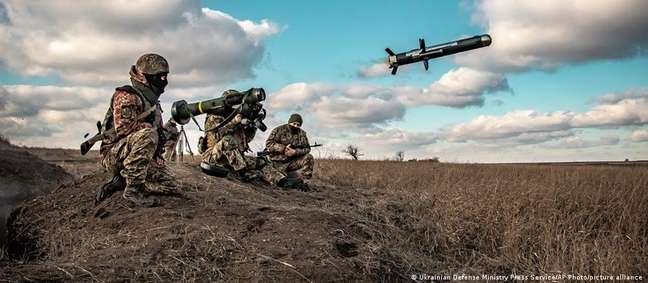In 2021, sales of the 100 largest arms manufacturers grew for the seventh consecutive year, despite the economic impact of the pandemic. The United States remains in the lead. The war in Ukraine is likely to affect future dynamics. Last year was not a good year for the economy: labor shortages, disrupted supply chains, and goods arriving late or not arriving at all. As in the previous year, the main reason for this was the covid-19 pandemic.

But despite the difficulties, the 100 largest arms producers in the world managed to together generate revenues of 592 billion dollars (R$3.1 trillion) in 2021, which corresponds to an increase of almost 2% compared to the previous year.
The United States still accounts for the largest share of this. US arms makers account for about half of global sales. However, sales in the US market decreased slightly in 2021.
“Problems caused by supply chain disruptions have hit US companies hardest,” said Xiao Liang, one of the authors of the latest annual report from the Sweden-based Stockholm International Peace Research Institute (SIPRI).
He sees the reason for the retraction in some kind of “long covid” of the economy, which has not yet recovered. “Besides, there is also high inflation in the US in 2021. Those are the two main reasons.”
Europe continues to arm itself
Sales in Europe, on the other hand, grew by 4.2% last year. And this was even before the Russian invasion of Ukraine on February 24, 2022. According to the Sipri 2022 report, the Russian war of aggression has increased the demand for weapons in Europe and the United States.
“With all the weapons being sent to Ukraine, the US and Europe were running out of stocks, which now need to be replenished,” Liang analyzes. “We are sure there will be more orders, but it is too early to say for sure whether this will translate into higher revenues as early as 2022.”
Currently, however, only German manufacturer Rheinmetall expects its defense division to see a 30% to 40% increase in orders won in 2023. This forecast is based on the need to replenish stocks of armored vehicles that have been sent to Ukraine.
lack of time
Future orders are not lacking, what is missing now is another resource: time. An example of this is the US order for Javelin anti-tank missiles. By the end of October 2022, the United States had delivered 8,500 of these missiles to Ukraine, the equivalent of three to four years of production. “Therefore, it’s a challenge for companies: They’re getting more orders, but will they be able to fulfill and deliver all the orders?” reflects Liang.
The longer the war lasts, the more urgent the question of how much weapons Western countries will send to Ukraine will become. “We see some countries already trying to find that balance,” Liang says. “It’s about balancing our needs with support for Ukraine. But at the same time we know that stocks are running out and we need to replenish them.”
Some European Union (EU) countries are arming themselves massively in response to Putin’s war of aggression. Poland wants to double the number of its soldiers in five years, Finland is strengthening its air defenses. Greece, France and Italy buy new weapons worth billions of euros.
Shortly after the outbreak of war, German Federal Chancellor Olaf Scholz announced a €100 billion special fund for the Bundeswehr, Germany’s armed forces.
Russian companies are stagnant
And Russia itself? “Russia’s defense industry grew only minimally in 2021, but that’s nothing new,” says Lang. According to the Sipri report, one of the reasons is the order given by the Russian government to the military-industrial complex in 2016 to increase civilian production.
The Russian invasion of Ukraine will likely reverse this trend, Lang said, as the defense industry will have to support the war effort. Currently, however, there is a lack of components for the production of weapons.
Economic sanctions imposed by Western countries prevent Russia from importing unrestricted chips and semiconductors, urgently needed parts for production, including the manufacture of rockets and tanks.
China and the Middle East
As for Asia and the Middle East, it is interesting to note that the Middle East is experiencing the fastest growth. The five companies headquartered in the region experienced the highest growth rate of any region represented in the top 100 in 2021.
An ongoing trend in Asia is that China, in particular, is accelerating the pace of production. In recent years, the country has become the second largest arms producer in the world, with only the United States currently producing more. The increase in arms sales reflects the degree of modernization of China’s military equipment and the country’s goal to become self-sufficient in the production of all major categories of weapons.
Between 2017 and 2021, China, as well as India, Egypt and Algeria, bought most of their weapons from Russia. However, the Sipri expert says it is still too early to know exactly how the Russian invasion of Ukraine is changing the market in this regard. “War will continue to influence the dynamics in the coming years,” Liang says.
🇧🇷The best content in your email for free. Choose your favorite Terra newsletter. Click here!
Source: Terra
Camila Luna is a writer at Gossipify, where she covers the latest movies and television series. With a passion for all things entertainment, Camila brings her unique perspective to her writing and offers readers an inside look at the industry. Camila is a graduate from the University of California, Los Angeles (UCLA) with a degree in English and is also a avid movie watcher.





-uv5u2g4fc853.png)

